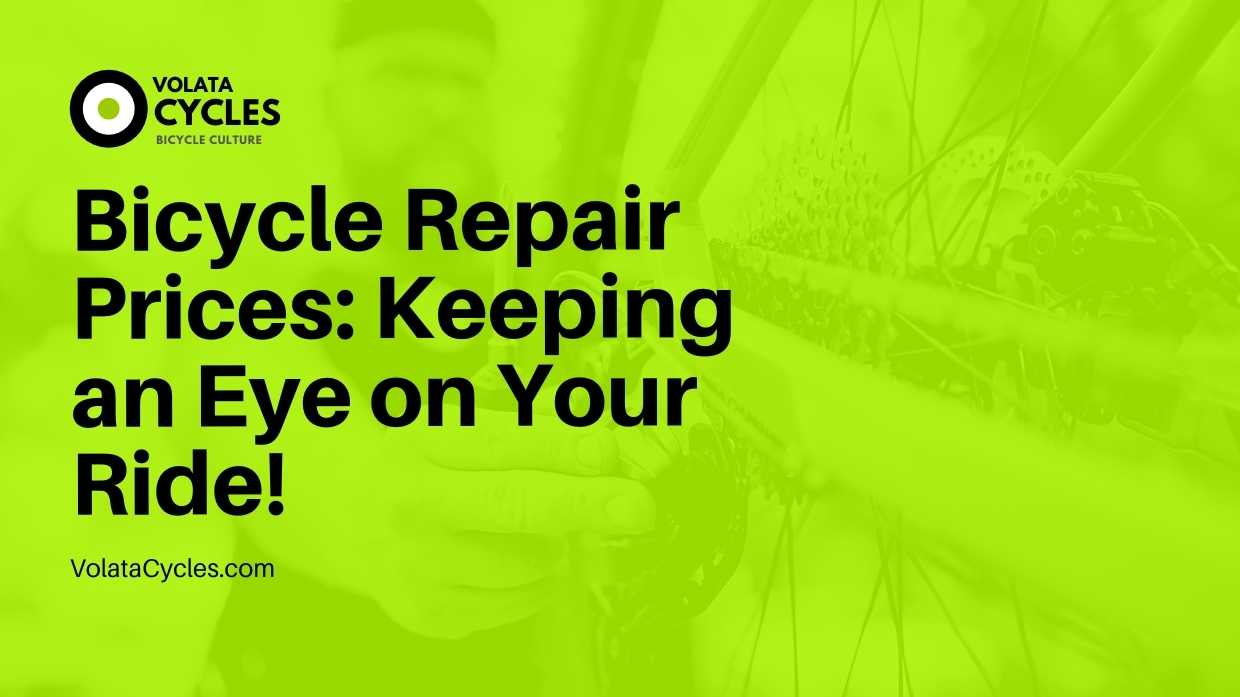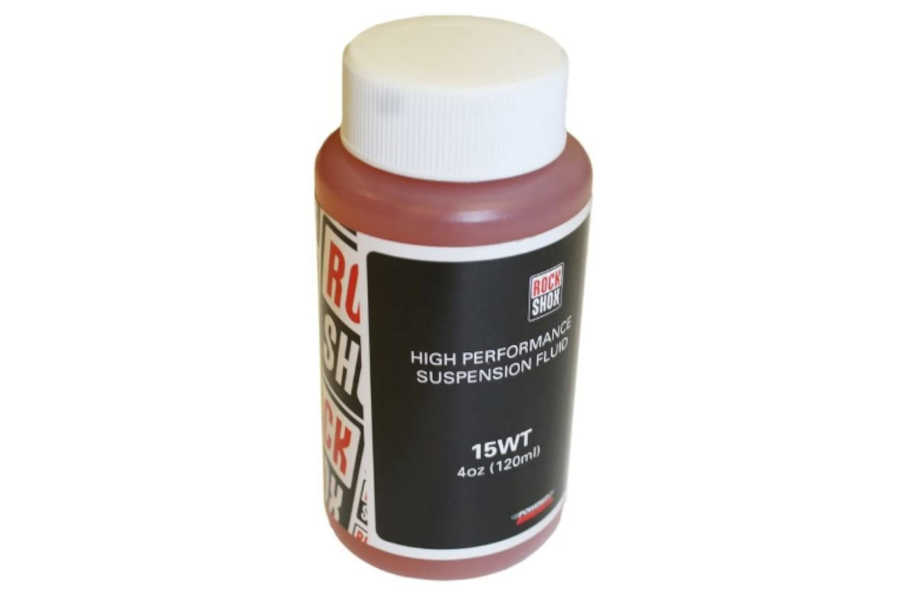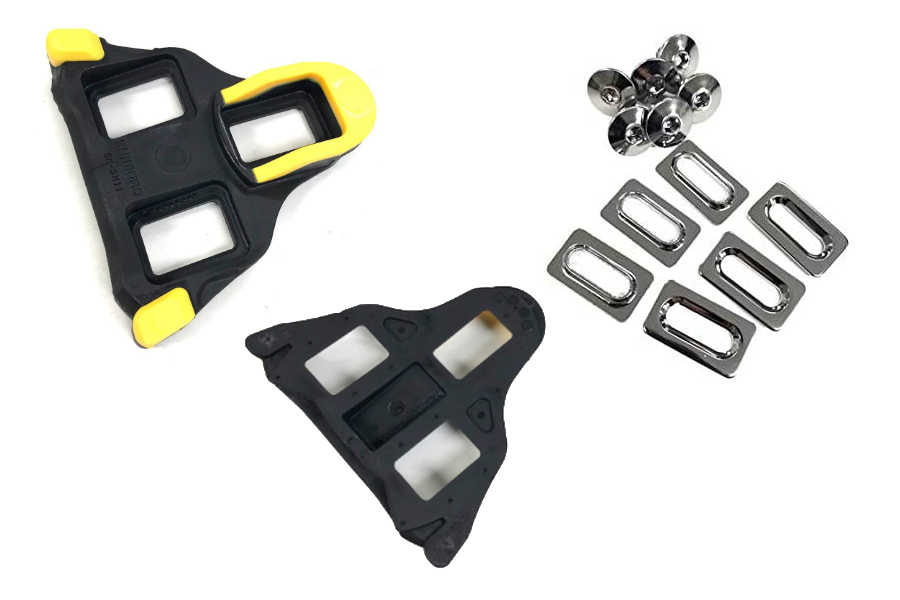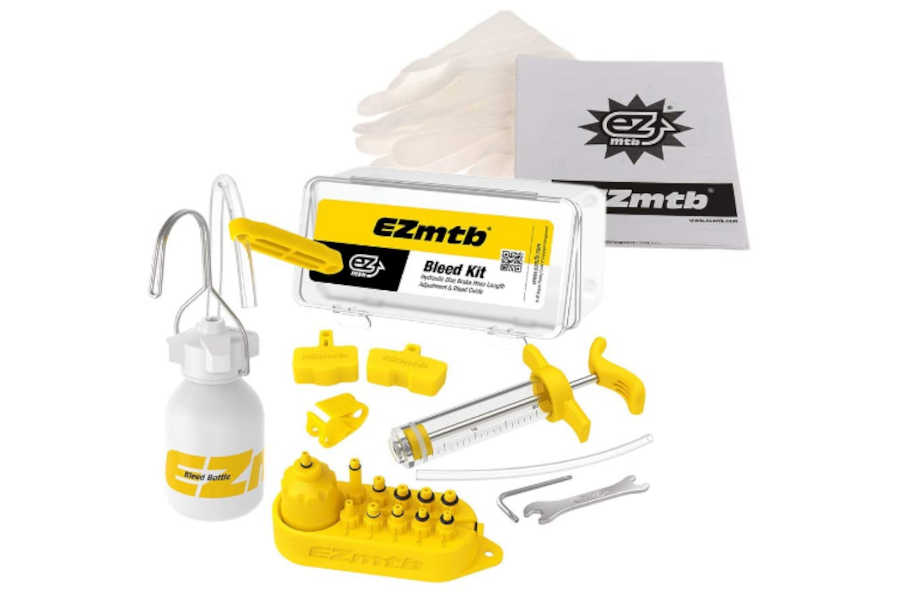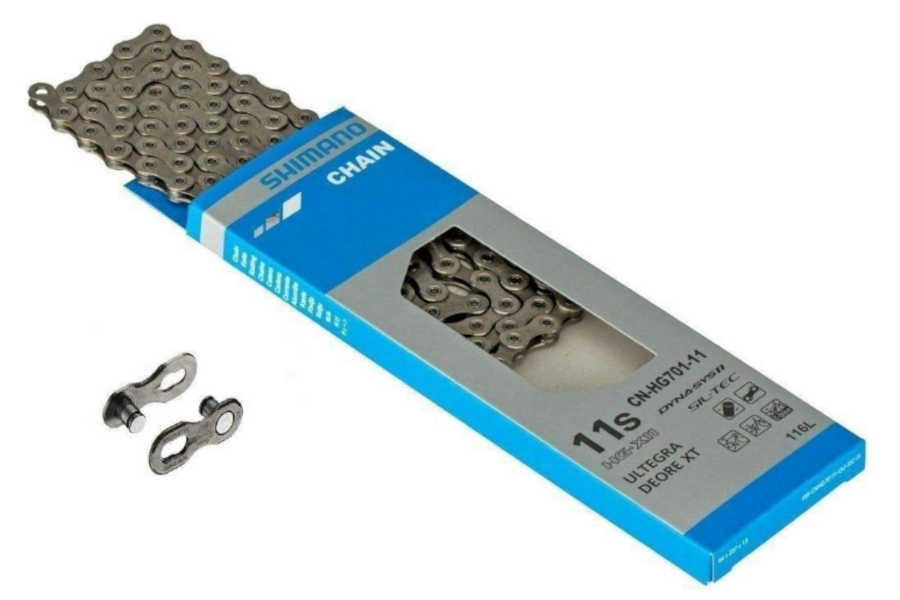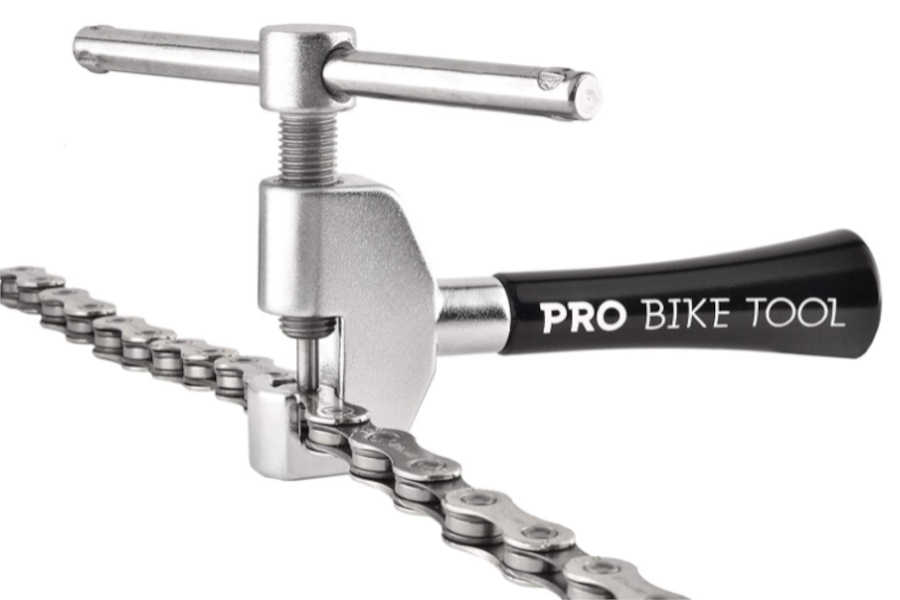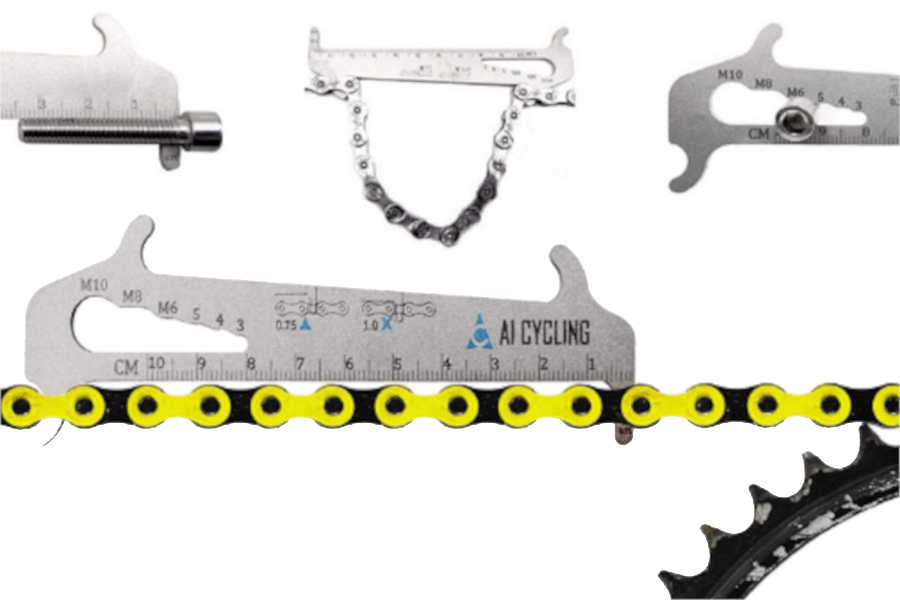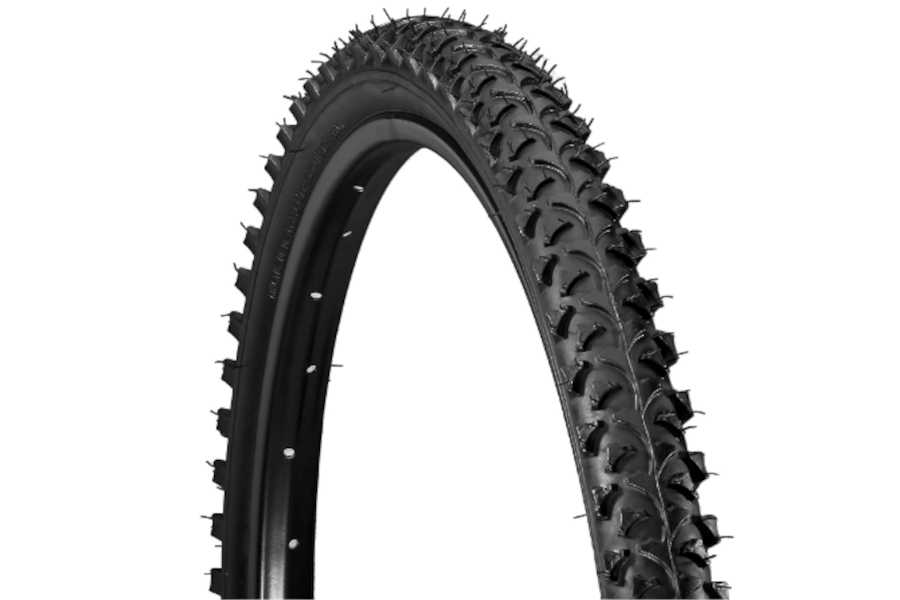The more in-depth you are about planning and scheduling maintenance, the better off you’ll be. Knowing everything from bicycle repair prices to what tools you need to perform certain repairs can help you take better care of your bike and keep it working well for longer.
From a novice rider to an experienced athlete, there is one crucial facet of cycling that every cyclist needs to keep in mind — routine maintenance. This is an inevitable part of bike ownership, but it can shatter the bank when you account for replacement parts and labor costs.
We’ll discuss the basics of what you can expect to do during your first few years as a new bike owner. While these things may vary depending on how frequently you ride, how many miles you put on your bike, and how often you battle through the rain, there are some general guidelines that can help keep your bicycle running at peak performance.
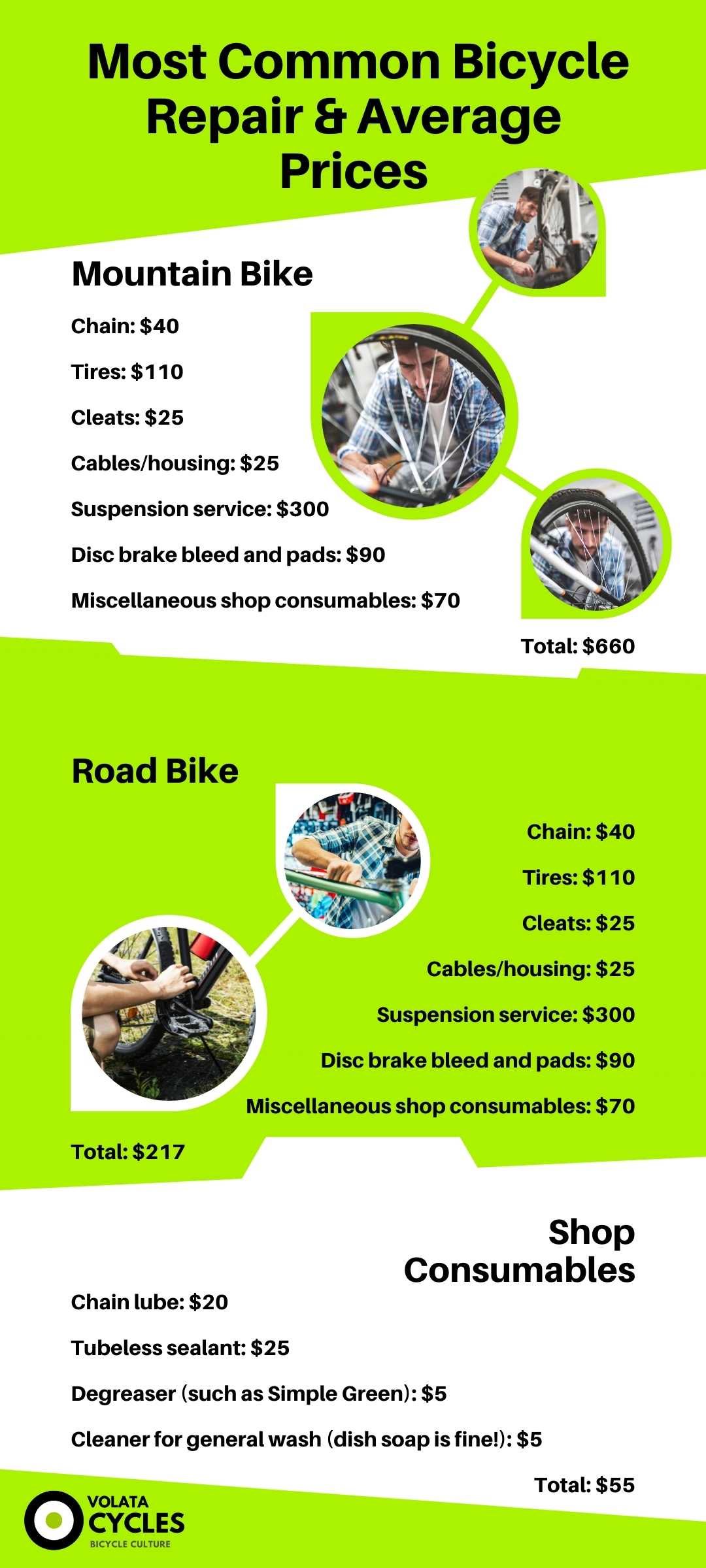
Bicycle Repair Prices
We’ll also leave out any fixes that aren’t due to normal wear and tear, like bent disc brake rotors, slashed tires, or broken spokes.
1. Suspension
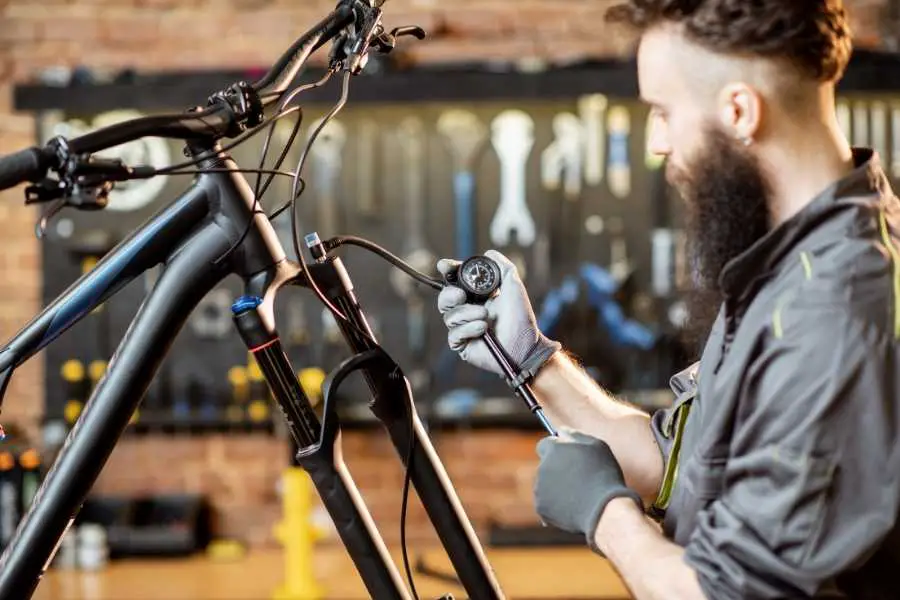
You’re not likely to enjoy riding around on a bike if your front fork is completely shot. In the same way, you won’t have much fun if the shock absorbers are about to go kaput on your bike. That’s why it’s critical to keep your suspension parts free of wear and tear. And it can be tricky to do by yourself. Especially if you’re DIY-challenged.
Because suspension maintenance is a technical and precise task, it can be difficult for do-it-yourselfers to take on the task. The best suspension service technicians are able to tackle any suspension repair or upgrade, but sometimes even they can’t do it all. If you want to keep your cherished vehicle running in the best condition possible, it may be worth the investment of paying a professional to handle some of your more involved suspension work.
Seals
Dust, dirt, and grime — all of these elements can wreak havoc on suspension forks and shocks. Fortunately, seals are the first line of defense in protecting your fork or shock from all of these elements. These rubber pieces go around the stanchions, ensuring you get the performance you’re looking for from your suspension.
Bushings
Bushings are plastic parts that sit inside your fork. These wear out over time, affecting its performance (particularly as the stanchions slide over them) Bushings are not terribly difficult to replace, but every major bike manufacturer has a different way of doing it which means you need a special tool for each set of bushings. A proper set of tools will cost you at least $100 — but you can probably make do with one or two $10 tools.
Oil Bath
An oil bath is a small amount of oil inside the lowers of most forks, and also inside the rear air shock. It is injected into the lower legs of a fork to keep it functioning smoothly for years to come. When a service is performed, drain the oil from the bath and replace it with new oil – we recommend the RockShox High-Performance Suspension Oil. Forks hold your front wheel off the ground so you can ride on anything from smooth pavement to steep hills. If you have air shocks, you generally have to unscrew them and pour out the oil yourself.
Check the Latest Price on Amazon.
Tips
For those of you who really do ride that often or race, servicing your fork on an annual basis makes sense. However, the average rider is probably not going to touch his fork for years at a time. After 50 hours of riding, RockShox recommends servicing your fork, while Fox recommends service after 125 hours or one year, whichever comes first.
For anyone who has never done it, recording and tracking suspension settings is a good habit. The values change as the bike is used more, which helps you determine how your bike is breaking in or how to keep it on top form.
If you can feel your suspension starting to stiffen, it’s time to take action. You know how that feels: the suspension is no longer working effectively, and you’re getting a rough ride. This can be caused by worn rubber in the dampers or by a misalignment of the springs, possibly leading you to change or add parts.
2. Cables and Housing
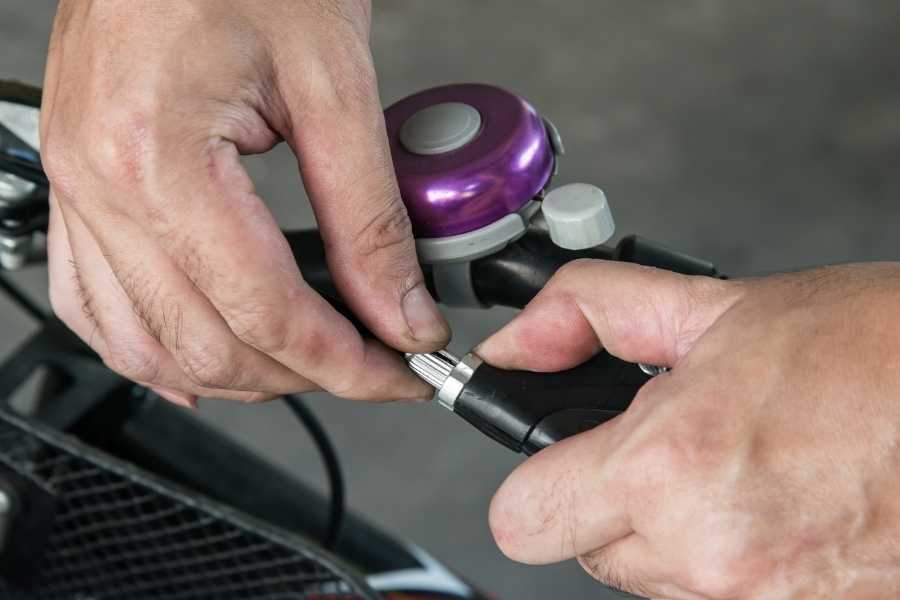
You’ll never know how much you need a new set of shift cables until they start to stick. If you notice that your bike is getting harder and harder to shift as time goes on, you could end up breaking your derailleur in an attempt to get from gear A to gear B.
The shift levers on many bikes get harder to shift as they wear over time, and the cable housing becomes almost as smooth. Replacing just the cable won’t bring back the crisp feel of a new shifter. For the best shifting performance, replace both at the same time. It doesn’t matter if you’re new to bikes or an expert — cables give out eventually, and it is always better to be safe than sorry.
Cable and housing maintenance is a tedious job that most cyclists avoid. You’ll need to replace cables and housing about once a year, depending on how often you ride in wet conditions. If you have a single chainring bike, you’re in luck — it’s far easier to replace the front cable than the rear! For electric shifting systems, maintenance is also minimal — just charge the battery when it gets low to ensure that the electronic shift works properly.
Tips
If you have internal cable routing on your bike frame, be aware of the number of housing tubes in the frame. Some cables can run inside a closed-off tube through the length of the built frame — for example, rear derailleur housing might run inside a full-length housing tube in the seat stays. If that’s the case, replacement will be simpler than replacing externally routed cables.
Cables running through a bicycle frame can be a nightmare to remove. If your bike has internal cable routing, you’ll need to cut and replace housing or cables before you can remove the cable. Fortunately, there are tools that make this process much easier. To do so, you’ll need a cable cutter, an Allen wrench set, and a new cable (always buy two). Estimated bicycle repair prices for these replacements? Around $15-20.
3. Clipless Pedal Cleats
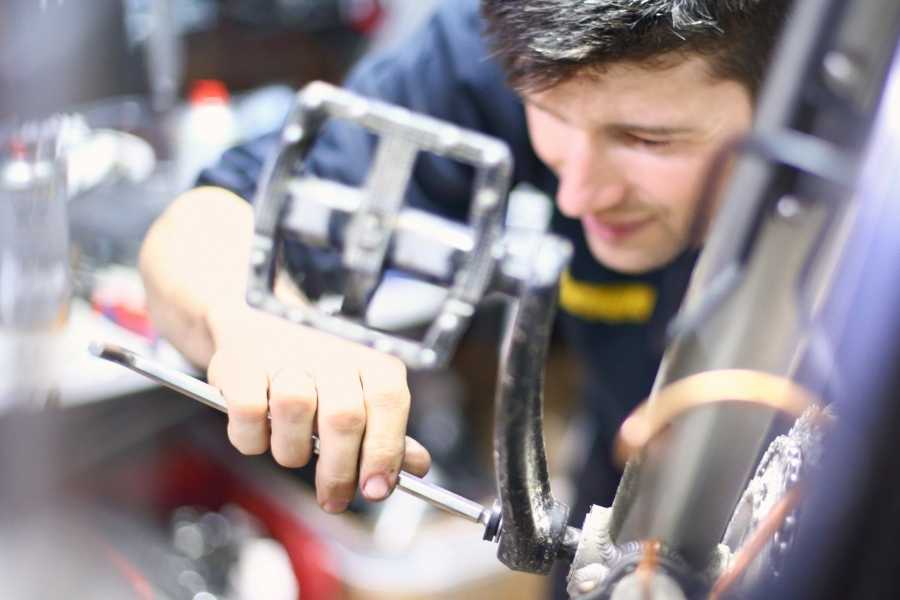
Cleaning your bike is a simple matter, such as cleaning your tires. You can tell they need some attention because you’re noticing that they are wearing unevenly. However, cleaning your clipless pedal cleats might not be as straightforward. Neglecting this small but important task could lead to nagging aches and pains and even knee injuries.
Just about the only thing that will slow mountain bike cleat wear are muddy conditions. In muddy conditions, road shoe cleats will wear faster due to the increased resistance from the mud and dirt. As well, walking around in your cleated bike shoes can also speed up the rate of cleat wear — plastic cleats like those offered by Look or Time are particularly susceptible to this phenomenon.
When your cleats are worn out, the pedal/cleat interface becomes loose. This can lead to unexpected releases from your pedals and can make you feel unstable on the pedals. Your feet will also feel unhinged from the pedals and might even squeak when you release.
Tips
Mountain bike pedals can be bought in both steel and brass varieties. Unfortunately, while steel cleats can last for thousands of miles, brass ones will only last for a hundred or so. That’s because steel has better lateral rigidity, which means that it’s much more capable of withstanding lateral forces.
Crankbrothers mountain bike pedals have brass cleats and can wear through their pedals quickly; the little grooves in the pedal are a good indicator that it is time to replace them. For those who are used to using steel SHIMANO Cleats SPD-SL, however, these grooves could seem alarming.
Check the Latest Price on Amazon.
The average bicycle repair prices of a replacement cleat range from $10 to $30. This will cover shoes that are less than six months old. You’ll also need an Allen wrench, or a 4mm wrench, to complete the replacement. Finally, it’s important to grease the bolts before removing the cleat because this will ensure that the new cleat stays on your shoe for as long as possible.
4. Brakes
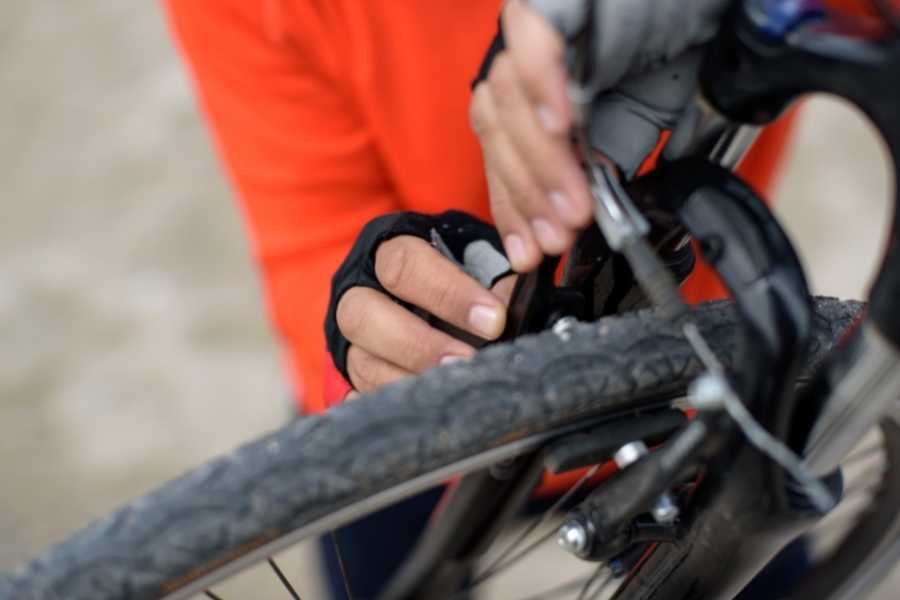
The first major step in any bike repair is to understand the different parts of your bicycle, in order to determine where the problem lies. If your bike has disc brakes, you’ll have a hard time completing this task because disc brakes are more advanced than caliper brakes. If you have caliper brakes on your bike, then this task will be much easier.
Cable-actuated caliper brakes are a common choice for many cyclists. While they are easy to maintain and tend to be lightweight, they have a lot of issues. Cables need to be replaced every year or two, and housing needs to be replaced at the same time because it tends to get gunked up. If not properly maintained, braking issues can arise. The frequency of brake pad replacement also largely depends on your routine and the climate you live in.
Rim Brake Pads
Rim brake pads are designed to be replaced when they wear down to a certain point, which is indicated by a “wear line” that you can see on the pad. The best way to do this is to place a rubber pad-removal pin into the hole where the caliper pin goes. Once this is done, the pads are free to slide out and you can replace them with new ones. But make sure to always replace both pads at once, as you won’t be able to stop if one is missing!
Hydraulic Disc Brakes
Replacing your disc brake pads can be a pop-in-and-out job, so long as you have the right tools. That being said, it won’t be a job for the novice. You’ll need to take out a pin to remove the pads from your rotors — a fairly straightforward process even if you’ve never done it before. However, not all of them have wear indicators, so you’ll have to determine when it’s time for a replacement yourself.
The most important part of repairing your own brakes is to avoid damaging the rotor. You could potentially mess up if you are not very careful, and cause it to rub on the pads. But, if you follow tutorials and know how to do it yourself, it will save you a lot of money from having a professional come out to do the work for you.
Bleeding Hydraulic Brakes
For bleeding hydraulic brakes, you’ll need a brake bleeder kit that includes all of the tools you’ll need. We recommend getting the Fireyouracing Mountain Bike Hydraulic Disc Brake DOT Mineral Oil Bleed Kit if you don’t have one yet. One end attaches to the bleeder valve and the other end connects to your tube or jug. Using the bleeder valve as an on and off switch, pump fluid onto it to allow air bubbles to escape. Repeat this process several times, then close the valve. Add fresh fluid through the bleed line and repeat until you see new fluid coming out in clean streams.
Check the Latest Price on Amazon.
Whether you’re the one bleeding your own brakes or you have a mechanic do the work, all riders should be able to tell if their brake pads are in need of replacement. If there is any sponginess when braking, a hard pull on the lever does not result in an immediate stop, or if the levers do not return to their original position after being depressed, it is probably time to replace them. This should happen about every year.
The estimated bicycle repair prices to replace your brake pads range from $20 to $40. The average cost for complete brake service at a bike repair shop is $100. But you can do it yourself in about an hour with tools that are available in any garage like needle-nose pliers, Allen wrench, brake fluid, and/or brake bleed kit (depending on which brakes you have).
5. Chain
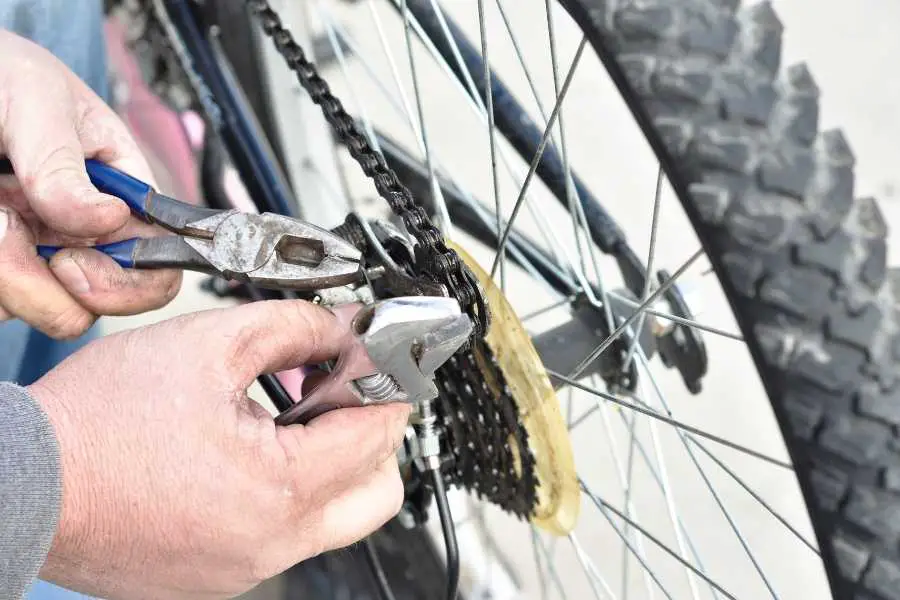
Most of us don’t pay attention to our bike chains until it’s too late. A bicycle chain is a simple piece of equipment, but it’s also one of the most important components on your bike. Without it, you might as well sit and stare at the wall all day. That’s why it’s critical to keep your chain in good working order. The saying goes “a chain is only as strong as its weakest link.” If your chain stretches, it’s bad for the cassette and the chainrings. It can wear them out completely, and that will mean a very costly repair.
A mountain bike chain should last you anywhere from 500-1,000 miles before it needs to be replaced. This is about half that of a road bike chain which typically lasts about 1,000-3,000 miles in ideal conditions. That’s why it’s best to invest in a high-quality mountain bike chain if you can afford it!
Shimano Ultegra/XT CN-HG701 11-Speed Chain
Check the Latest Price on Amazon.
If your bike chain is more than half an inch long, that means it’s time to get a replacement. How do you tell? If it’s worn beyond its serviceable limit, the teeth will become thin and far apart, making it harder to pedal and causing your gears to skip.
Tips
Using Strava is a great way to track wear on bicycle parts — especially for chains. The detailed reports will let you know if your chain is wearing out, and when it’s time for a replacement! Plus, all of your riding histories will stay on file, so you can check those past stats whenever you want.
If you are looking to replace your bike chain, make sure you have a quick-link removal tool like a chain breaker and then a chain checker. Make sure that the chain is compatible with the derailleur and the other parts of your bike.
PRO BIKE TOOL Universal Chain Tool
Check the Latest Price on Amazon.
VANICE 4 in 1 Bicycle Chain Checker
Check the Latest Price on Amazon.
The bicycle repair prices for a chain replacement actually depend but be prepared to allocate at least $35.
6. Tires
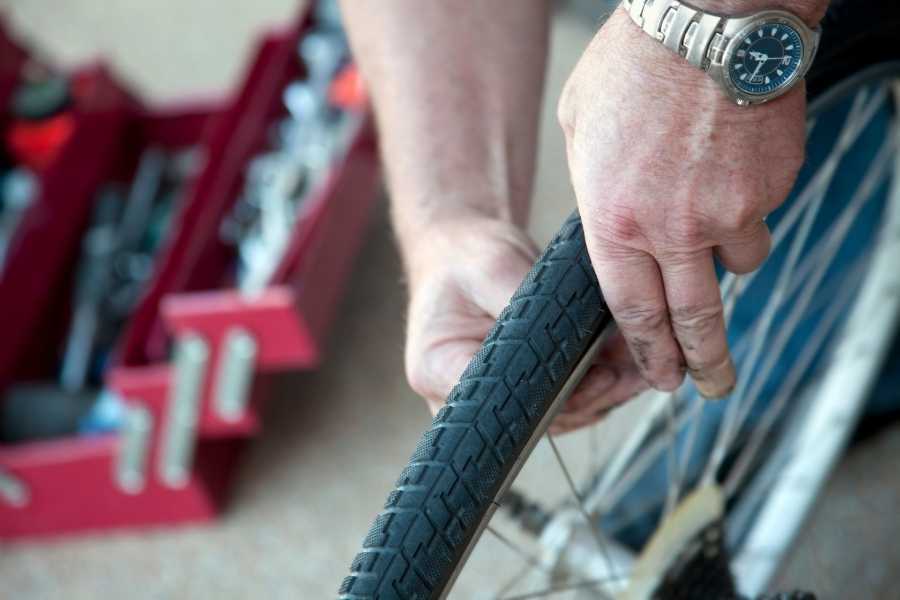
Tires are one of the most important parts of cycling, so it is vital to make sure they are performing at optimum levels. But how do you tell that your bike tires need replacement? Though there’s no set rule to follow, there are a few tell-tale signs that indicate an old tread is on its way out.
We’ve all heard that a penny saved is a penny earned, and the same is true of bike tires. Since you’re likely to get more use out of your bicycle with expenditure on quality tires, rather than having to constantly replace cheaper models, it’s important to understand the factors that can make a tire last longer and how to select the right model for your riding style.
Your tires’ tread wear indicators are the key to getting the most out of your tires. Wear indicators are small grooves in the center of a tire’s tread. They’re designed to last for a certain amount of time before they disappear and indicate that it is time either to replace your tires or get them rotated and adjusted to keep you safe on the road.
Lightweight Tires
Lightweight bicycle tires are not going to last as long as their heavier counterparts. They may wear faster, depending on a variety of factors: the type of road you’re riding on, the tire pressure you’re using, and the amount of stress you put your bike through.
Knobby Tires
Knobby tires are known to be a challenge when it comes to determining when they need to be replaced. When your tire’s knobs get worn down, it’s hard to tell whether or not the rubber has gone completely. If you’re riding your bike in serious terrain, you’re going to want to inspect your tires regularly. Always check the profile of the tire: it will feel harder when you squeeze it, and when you look at it in profile, you’ll see visibly rounded and shorter knobs.
Schwinn Replacement Bike Tire
Check the Latest Price on Amazon.
Riding over any hard, sun-baked surface can cause decreased traction. This is especially true if you’re braking or climbing steeply or turning sharply — for example, on a rocky trail or singletrack. The center of a bicycle tire wears out before the sides do.
It all depends on your riding style. You might prefer a lower-profile tread for climbing or a taller one that grabs dirt and roots better for the descent. If you’re racing, however, you may need the utmost grip for maximum performance.
Tips
If you want to increase the longevity of your tires, rotate them around so the rear tire wears out as quickly as the front. By switching around your tires, you’ll make both last longer.
When the rear tire on your mountain bike wears down to the point where the risk of a blowout is too great to continue riding, you can install a new front tire and install the old front tire to the back. This way, you’ll have most of your original treads at the front of your bike — where traction and steering are more important — and you won’t have to replace both tires at once.
The bicycle repair prices for this will be about $50. It takes less than half an hour to complete but only if you have the right tools for the job. You’ll need a tubeless sealant (if you use it), tire levers (if you use them), a tire pressure gauge, and a mini bicycle pump or an air compressor pump.
Example Annual Bicycle Repair Prices
Here’s an example of what a typical bike maintenance budget might look like. Yours will depend on how often you ride and how much you are willing to do it yourself. In the first year, you won’t have to spend too much. All the parts will be new and free from defects. However, as time passes, you’ll start needing to replace some of the parts that get worn out. This is due to the fact that bikes are actually very fragile pieces of equipment.
Road Bike
The annual upkeep on a road bike can be intimidating. No one likes to spend more than they need to, but when it comes to your hobby, you must prioritize. Expensive components mean that if you don’t take care of them, they’ll stop working — and so will you! Avoid maintenance costs by doing basic tasks yourself — in fact, many parts are easy to service on your own. The average annual maintenance budget/bicycle repair prices for road bikes is $217.
Tire: $60
Chain: $40
Cleats: $25
Cables/housing: $12
Disc brake pads: $25
Miscellaneous shop consumables: $55
Mountain Bike
The annual bike maintenance budget for mountain bike is a bit higher than other heavy-use bikes because of the frequent sharp impacts and abrasions caused by its rugged terrain, and it may require a bit of DIY. The average annual maintenance budget/bicycle repair prices for road bikes is $660.
Chain: $40
Tires: $110
Cleats: $25
Cables/housing: $25
Suspension service: $300
Disc brake bleed and pads: $90
Miscellaneous shop consumables: $70
Shop Consumables
Bike owners on a budget should consider buying consumables. Instead of investing in an expensive bike, add to your collection with small items that cost less than $55 but can make your ride feel fresh and new again. These items are easy to transport and keep you both safe and comfortable on the road.
Chain lube: $20
Tubeless sealant: $25
Degreaser (such as Simple Green): $5
Cleaner for general wash (dish soap is fine!): $5
Conclusion
Bicycle repairs can be expensive, and sometimes a product replacement is the only way to go. However, by watching for bicycle repair prices, you might be able to save your wallet from unnecessary burdens. Bicycle-related problems can happen at any time. So, it’s important to stay on top of the issues such as flat tires or frozen cables and not have to pay for a full replacement.
Hope you’ve found this article about bicycle repair prices to be informative and useful. We’d love to hear your feedback; please leave me a comment below!
Thanks for reading!

